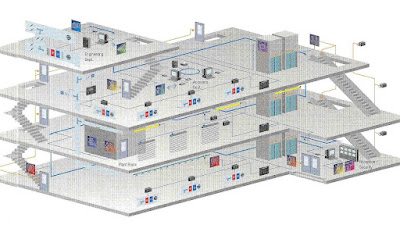Building Automation Systems Create A Consistent, Comfortable Climate, Ensure Everyone's Safety, And Save Energy
 |
| Building Automation Systems |
A centralised, networked system of hardware and software that
keeps track of and manages the facilities systems of a building (electricity,
lighting, plumbing, HVAC, water supply, etc.).
Tenants benefit from a more comfortable working environment,
while facility management reaps the rewards of sustainable practises and lower
energy costs when facilities are monitored and regulated seamlessly.
A system, or group of systems, that offer automated control
and monitoring inside a building is known as a Building
Automation Systems. Since these systems are under centralised control, a
limited number of stations dispersed around the building can be used to monitor
and modify them. Consider your home's thermostat as an illustration. These
days, the majority are programmable, enabling you to change settings for heat,
air conditioning, zones, temperatures within zones, and various time of day.
Similar building automation, but on a greater scale. They are designed to
create a consistent, comfortable climate, guarantee everyone's safety, and save
energy.
Building Automation
Systems regulate a
variety of structural elements, including heating, ventilation, and air
conditioning (HVAC). Performance and sustainability of the HVAC system are
essential for modern building operations.
This kind of infrastructure's main objectives are to raise
safety, lower costs, and increase system efficiency. All of these components
are combined by a centralised building management platform, however this
explanation simplifies what actually occurs behind the scenes.
Building Automation
Systems can be
installed during new construction or as part of a retrofit for an existing
building.
In order to produce a
smart building environment, it uses five component categories-
Sensors: These tools monitor a variety of
parameters, including temperature, humidity, the number of occupants in a
space, and lighting intensity. These data are sent to central controllers by
the sensors.
Controller: The "brain" of the BAS is
the component known as the controller. It gathers data from the sensors and
then issues commands to connected components including HVAC units, lighting
systems, security alarms, and more.
Output devices: When the controller issues a
command, actuators and relays operate accordingly to carry out the
instructions. They might adjust the temperature in a specific area of the
building, dim the lights in empty offices, or switch on the air conditioning
before employees arrive for work, for instance.
Communication protocols: Each component of the BAS can understand the language that is used by the BAS. The most popular choices are BACnet and Modbus.
Terminal interface: Users can communicate with the BAS
through the terminal interface. Users might opt to manually override settings
or monitor the building's condition using the information that is provided.



Comments
Post a Comment